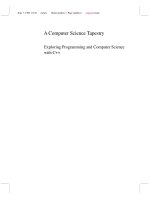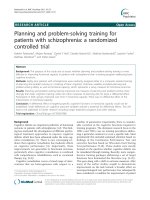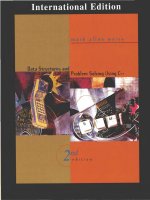programming and problem solving with c++ 6th by dale ch03
Bạn đang xem bản rút gọn của tài liệu. Xem và tải ngay bản đầy đủ của tài liệu tại đây (478.37 KB, 80 trang )
Chapter 3
Numeric Types, Expressions,
and Output
Chapter 3 Topics
●
●
●
●
●
Constants of Type int and float
Evaluating Arithmetic Expressions
Implicit Type Coercion and Explicit Type Conversion
Calling a Value-Returning Function
Using Function Arguments
Chapter 3 Topics
●
●
●
●
Using C++ Library Functions in Expressions
Calling a Void Function
C++ Manipulators to Format Output
String Operations
length, find, and substr
C++ Data Types
simple
integral
enum
structured
floating
array struct union class
char short int long bool
float double long double
address
pointer
reference
C++ Simple Data Types
simple types
integral
char
short
int
unsigned
long
floating
bool
enum
float
double
long double
Standard Data Types in C++
●
●
Integral Types (or Integer Types)
■
represent whole numbers and their negatives
■
declared as int, short, long, or char
Floating Types
■
represent real numbers with a decimal point
■
declared as float or double
Standard Data Types in C++
●
Character Type
■
represents single characters such as 'B'
■
declared as char
■
classified as an integral type because C++ allows char to be
used for storing integer values with a limited range
Samples of C++ Data Values
int
sample values
4578
-4578
float sample values
95.274
95.
9521E-3
-95E-1
char
0
.265
95.213E2
sample values
‘B’
‘d’
‘4’
‘?’
‘*’
Scientific Notation
2.7E4 means 2.7 x 10 4 =
2.7000
=
27000.0
2.7E-4 means 2.7 x 10 - 4 =
0002.7
0.00027
=
More About Floating Point Values
●
●
Floating point numbers have an
integer part and a fractional part,
with a decimal point in between.
Either the integer part or the
fractional part, but not both, may be
missing
Examples
.8
18.4
500.
- 127.358
More About Floating Point Values
●
●
Alternatively, floating point values
can have an exponent, as in
scientific notation
The number preceding the letter E
doesn’t need to include a decimal
point
Examples
8E-1
-.127358E3
1.84E1
5E2
Division Operator
●
●
●
●
The result of the division operator
depends on the type of its operands
If one or both operands has a floating
point type, the result is a floating
point type.
Otherwise, the result is an integer type
Examples
11 / 4
has value
2
11.0 / 4.0
has value
2.75
11 /
4.0
has value
2.75
Main returns an int value
to the operating system
//*******************************************************
// FreezeBoil program
// This program computes the midpoint between
// the freezing and boiling points of water
//*******************************************************
#include < iostream >
using namespace std;
const float FREEZE_PT = 32.0; // Freezing point of
water
const float BOIL_PT = 212.0; // Boiling point of water
int
{
main()
float avgTemp;
// Holds the result of averaging
// FREEZE_PT and BOIL_PT
Function main Continued
cout << “Water freezes at “ << FREEZE_PT << endl;
cout << “ and boils at “ << BOIL_PT
<< “ degrees.” << endl;
avgTemp
avgTemp
cout
cout
FREEZE_PT + BOIL_PT;
avgTemp / 2.0;
<<
<<
return
}
=
=
“Halfway between is “;
avgTemp << “ degrees.”
0;
<<
endl;
Modulus Operator
●
●
●
The modulus operator % can only
be used with integer type operands
and always has an integer type
result
Its result is the integer type
remainder of an integer division
Example
11 % 4
because
4 ) 11
Rhas
= ? value
3
More C++ Operators
int
age;
age = 8;
8
age
age = age + 1;
9
age
Prefix Form
Increment Operator
int
age;
8
age = 8;
age
++age;
9
age
Postfix Form
Increment Operator
int
age;
8
age = 8;
age
age++;
9
age
Decrement Operator
int
dogs;
100
dogs = 100;
dogs
dogs--;
99
dogs
Which Form to Use
●
When the increment(or decrement) operator is used in a
“stand alone” statement solely to add one(or subtract
one) from a variable’s value, it can be used in either
prefix or postfix form
USE EITHER
dogs--;
--dogs;
BUT...
●
When the increment (or decrement) operator is used in
a statement with other operators, the prefix and
postfix forms can yield
different
results
We’ll see how later . . .
What is an Expression in C++?
●
An expression is a valid
arrangement of variables,
constants, and operators
●
In C++ each expression can be
evaluated to compute a value of
a given type
●
The value of the expression
9.3 * 4.5
is
41.85
Operators can be
binary involving 2 operands
unary
2 + 3
involving 1 operand
ternary
involving 3 operands
- 3
later
Some C++ Operators
Precedence
Higher
Operator Description
( )
*
/
+
-
Lower
Assignment
Function call
+
Positive
Negative
Multiplication
Division
%
Modulus(remainder)
Addition
Subtraction
=
Precedence
●
Higher Precedence determines which operator is
applied first in an expression having several
operators









